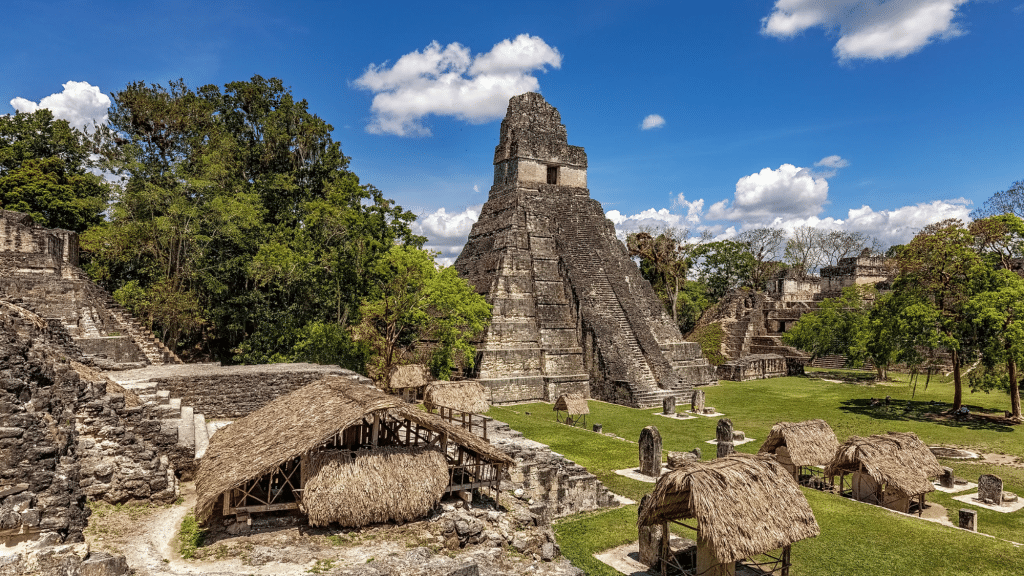The Maya people created one of history’s most amazing societies in Central America.
Their culture lasted for thousands of years and left a rich legacy that continues to attract scholars and visitors alike.
This blog is here to take you into the world of the Maya. You’ll learn new and interesting things about how they lived, what they made, and what they left behind.
Are you ready to learn something different about the Maya? These facts may change the way you think about this ancient group of people.
1. Origins and Timeline of Maya Society
The Maya lived in what is now Mexico, Guatemala, and Belize. Their land stretched across the Yucatán Peninsula and nearby areas.
This region offered both lowlands and highlands with different climates. The varied land helped their society grow and progress for many years.
2. First Communities and Early City Growth
Maya people began living in small villages around 2600 BC. They started growing crops and setting up permanent homes.
Their first true cities with stone buildings appeared around 750 BC. These early towns marked the start of their complex society.
3. Key Periods in Maya History
Maya history splits into three main parts. The Preclassic period ran from 2000 BC to 250 AD. Then came the Classic period, which lasted from 250 to 900 AD, when they reached their peak.
The Postclassic period lasted from 950 to 1539 AD, with cities like Mayapán rising to power.
4. Main Foods and Farming Methods
Corn was the base of Maya meals every day. In their fields, they also grew beans, squash, and hot peppers.
Later, they added sweet manioc to their crops. These foods fed their growing cities for many years.
5. Building Methods and City Layouts
Maya builders created massive stone structures without metal tools. They made temples that rose high above the jungle.
Their work shows great skill in moving and placing huge stones. Many of their buildings still stand today.
6. Structure of Maya Towns and Settlements
Maya cities grew outward from a central area with temples. The middle held places for worship and government buildings.
Homes spread out from this center in a less planned way. Some cities are connected to others using raised roads.
7. Unique Writing Method of The Maya
The Maya created one of the most complete writing systems in the Americas. They used symbols that represented ideas and sounds.
This system allowed them to write down history, stories, and royal family lines. Scribes were highly regarded in their society.
8. Books and Record-Keeping Practices
Well, Maya books were made from paper created from fig tree bark. These folded books, called codices, held their knowledge and history.
Sadly, Spanish priests burned most of these books. Only four main codices still exist today.
9. Star Study and Calendar Systems
Maya sky watchers tracked stars with superb skill. They could predict sun and moon cycles with great care. Their calendar system included a 260-day count and a 365-day year.
This knowledge helped plan planting, wars, and sacred events.
10. Math Knowledge and Number Concepts
The Maya math used a base-20 system, unlike our base-10 system. They worked with huge numbers using just three symbols.
Most importantly, they used zero as both a placeholder and a number. This math helped with trade, building, and watching the stars.
11. Social Classes and Power Structure
This society had clear ranks from slaves to nobles. Farmers and workers made up most of the people.
Skilled craft makers, traders, and warriors held middle status. Priests and nobles stood just below the king in power. Each person knew their place from birth.
12. Kings and Religious Practices
The kings claimed direct links to the gods and led both political and holy tasks. Priests held events with dance, music, and sometimes blood offerings.
The king’s main job was keeping peace with the gods through rituals. Both men and women could serve as religious leaders, with some women holding key roles as seers.
13. Women in Maya Society
Women in Maya culture had more rights than in many ancient groups. Some royal women ruled cities when male heirs were too young. They owned property and could run businesses.
Women worked as healers, cloth makers, and sometimes as priestesses. Their roles are shown in art, where they appear in many important scenes.
14. Body Changes for Beauty and Status
Maya’s parents would press boards against babies’ foreheads to create a sloped look. High-status people also filed their teeth into points.
Some put jade pieces in their teeth for show. These changes marked social rank.
15. Markings and Skin Art Traditions
Both men and women in Maya society wore permanent skin art. These marks could show their family group, rank, or personal feats.
The designs used plants and minerals for colors. Many images matched those found on buildings and pottery.
16. Health Practices and Plant Medicine
The healers knew hundreds of helpful plants from their forests. They treated pain, fever, wounds, and many common sicknesses.
Some of these plant cures still work today. Healers held an important place in Maya towns.
17. Warfare and Military Structure
Maya warfare was both planned and holy. Elite fighters used spears, clubs, and later bows with arrows, and cities had guard posts and sometimes walls for safety.
Wars aimed to catch enemies alive for showing off and offering to the gods. Military leaders gained fame through success in battle.
18. Major Cities and Their Conflicts
Cities like Tikal and Calakmul grew very large during the Classic period.
These city-states often fought for control of trade and farming lands. At their height, some cities had over 100,000 people. Their wars are recorded in stone carvings.
19. Trading Systems Between Regions
The Maya traded goods across their whole area. Coastal groups traded salt and fish to inland cities.
Highland areas sent obsidian and jade to lowland towns. This trade moved along roads and water routes. Salt was worth almost as much as gold.
20. Reasons for The Fall of Maya Cities
Many southern Maya cities emptied around 900 AD. This change came from many causes working together:
- Long dry spells that hurt farming
- Cutting too many trees, which changed the land
- Constant wars between city-states
- Food problems from growing too many people
The fall happened over many years, not all at once.
21. Later Cities that Rose to Power
After southern cities fell, places like Chichén Itzá grew in the north. These newer cities showed mixed styles with outside effects.
They stayed strong until the 1400s in many areas, and some lasted until Spanish ships arrived.
22. Temple and Building Features
Their temples rose in steps toward the sky and covered stone bases with colored plaster and carvings.
Many had roof combs that made them look even taller. Temples faced key directions and lined up with the sun’s path.
23. The Ball Sport and Its Meaning
The Maya people played a ball game using rubber balls and stone courts. Players could only hit the ball with their hips and shoulders.
The game had deep, holy meaning beyond just sport. Some games ended with the losing team’s captain being killed.
24. Art Forms and Craft Skills
Maya artists made fine pottery with bright colors and scenes, carved stone with great detail, and painted walls with vivid scenes.
Their art shows daily life, wars, gods, and sky events. Even common items were made with care and skill.
25. Spanish Contact and Modern Maya Life
Spanish forces brought huge changes to Maya lands in the 1500s. A new sickness killed many people, while others faced forced work.
Despite these troubles, Maya culture survived. Today, about seven million Maya people keep their language and ways alive.
Wrapping It Up
The Maya story shows us how a society can build greatness from simple beginnings. Their cities, writing, and math skills prove human potential without modern tools.
So, the next time you see a photo of stepped temples or a Maya calendar, think about the real people who made them.
Their story teaches us that societies can create lasting marks on history through skill and careful planning.
Want to learn more? Visit a Maya site or museum to see their works.















